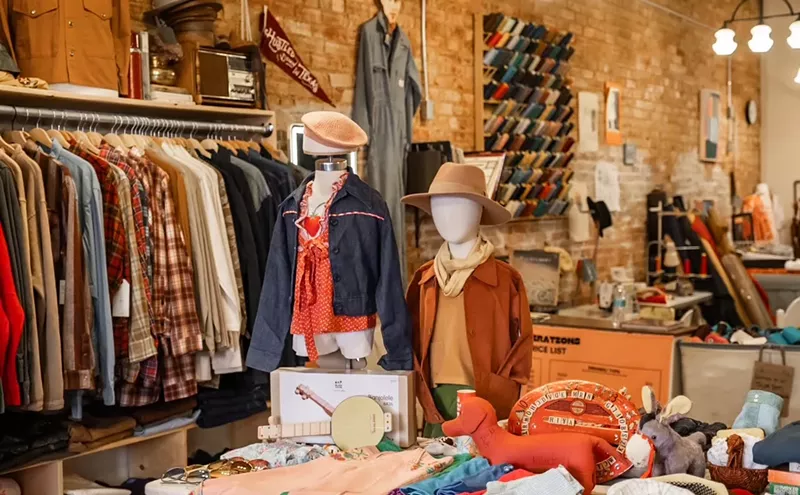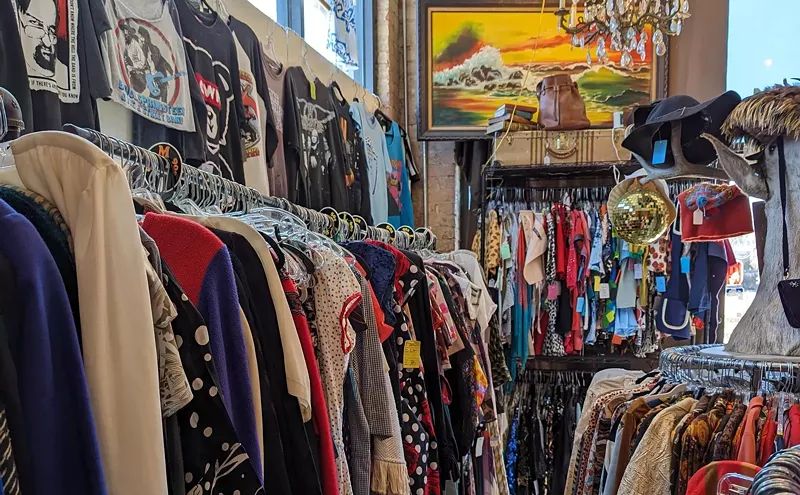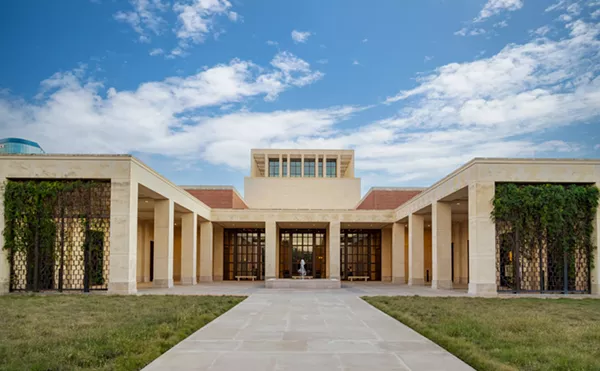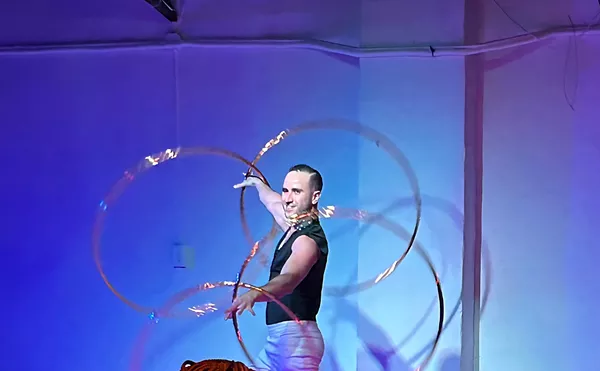Times are tough all around, and especially for artists. Grant money is scarce and patron support isn't what it was during boom times.
Why not offer Dallas artists and creative entrepreneurs a shot at some money and a bit of buzz-generating publicity? Dallas Observer's first MasterMinds competition, launched in September, is doing just that by awarding no-strings-attached prizes of $2,000 to each of three local artists working in a variety of media—visual arts, performance, video, film and arts advocacy. The goal: To honor cultural innovators with funds to do with as they choose, whether it's seed money for a new project or just to pay rent. OK, it's not a MacArthur Genius Grant. At least not yet. But we hope the money will allow the winners a little breathing room on their bills, or even inspire them to help out a fellow artist in need. (This year's winners will participate in choosing next year's prize recipients.)
We received more than 70 submissions during the month-long nomination period. The nine finalists, chosen by a panel of Dallas Observer editors and critics, all contribute considerable energy and talent to Dallas' cultural landscape. From this group, we'll choose the three winners who will be profiled in a cover story November 11. We'll celebrate them and all the finalists on Saturday, November 13, from 8-11 p.m. at our first Artopia event in Victory Park, where many of the finalists' work will be on view. Hope to see you there.
Now meet the finalists (in alphabetical order):
Karen Blessen
Artist, writer, teacher and peace advocate Karen Blessen saw her life and career take a dramatic shift after an act of violence left a stranger dead on her front lawn in Lakewood a decade ago. She says she spent "three dark years" chronicling the effects of the murder on the victim's family and friends as well as the families of the perpetrators.
After publication of the story she wrote and illustrated titled "One Bullet," she felt the need to shift her creative energies into a more positive direction. Immersion in a meditation practice that includes memorizing lines of sacred texts resulted in a creative burst. Over several months, Blessen built a series of small sculptures titled 29 Pieces, a collection of assemblages and script-covered tableaux that contain bits of text by mystics and religious figures such as St. Theresa of Lisieux and St. Augustine. Her long-term plan is to recreate each piece into a huge room-size (or larger) multimedia installation that will become a traveling exhibit. "It's time for artists to work on a larger scale," she says. "Art is going to manifest in ways we can't even anticipate yet."
A Pulitzer winner in 1989 for her work as a graphic artist at The Dallas Morning News, Blessen, 58, now is dedicated to using "art to create awareness of social issues." She's the co-founder of the nonprofit Today Marks the Beginning, which uses art and the teaching of art to promote peace and justice. She started and now manages the sister program MasterPEACE, which teaches lessons in non-violence and peace through artistic expression to classes of fifth-graders in eight Dallas-area schools. Using yoga masters, actors, musicians and other artists, MasterPEACE introduces students to Heroes of Peace, including Gandhi, Mother Teresa and others. Blessen has had these kids' art pieces—much of it constructed from found objects—displayed publicly and published in coffee-table book form.
Frank Campagna
Many a young artist's career has been launched from the walls of Frank Campagna's Kettle Art Gallery since it opened on Elm Street in Deep Ellum in November 2005. Campagna has only one requirement for submissions by unknown, un-shown artists. "You have to drop in here on a Thursday night, show me the stuff and shoot the shit with me for a couple of hours," he says. If he likes the art and the artist, the work will be up in the next group show (there's a new show every three to six weeks). If the work sells, the artist is bumped up to a three-artist show, then possibly a solo. Campagna keeps prices affordable and the work edgy and raw. "What's underground today will be mainstream 20 years from now," he says.
It's Campagna's own work as a muralist that has added to Deep Ellum's color and character for the past three decades. He estimates he painted on the outside wall of the Gypsy Tea Room 1,000 murals promoting acts that appeared there over eight years. He organized several end-to-end paintings of the now-demolished quarter-mile Good-Latimer tunnel and, during federal hearings about art for the new DART station in Deep Ellum, he fought against the installation of anything there that wasn't locally made. He won. Deep Ellum's own Brandon Oldenburg and Brad Oldham were awarded a $1.38 million contract to construct the three Traveling Man sculptures.
Business is down at Kettle lately, but Campagna, who's been mentor and father figure to a generation of North Texas artists, hopes the renewed revitalization of Deep Ellum sees things pick up. With daughter Amber helping to run the gallery, Campagna, 54, still has one unfulfilled dream as a muralist. He wants to spray-paint a huge wall in the style of the Impressionists. "But art is what does not pay," he says. "I want to see music and art happen side by side in this city again. But it's tough."
Simeen Farhat
In cyclones of Arabic words, the sculptural pieces by Simeen Farhat tell stories of poetry and pain. Born in Pakistan, Farhat came to Texas with a now ex-husband and earned a graduate degree from Texas Christian University. At 38, she divides her time between teaching art at community colleges and making art in the dining room of her century-old apartment on Swiss Avenue.
Using a jigsaw, Farhat cuts Arabic letters and phrases out of medium-density fiberboard, words chosen from Persian poems in Farsi and Urdu (her first language). Pegged together with tiny pieces of wood, the words are assembled into tornado-like shapes that convey a frenzied energy. The messages in the whorls of words reveal Farhat's responses to such issues as the "honor killings" of women in the Middle East.
"My work is feminist," she says. "After 9/11, I started questioning my identity as an artist."
She also makes ghostly figures of veiled women, three-dimensional sculptures that spew from their mouths Arab script in red and yellow. These pieces were featured last year in a one-woman show at the McKinney Avenue Contemporary titled "We Won't Kill You."
Farhat is just back from a solo show at the Xerxes Fine Arts gallery in London and her work will be shown over the next few months in Paris and Abu Dhabi.
"I tell my students to question, challenge that which puts you on edge," Farhat says. "Art should always start with what bothers you."
Joey Folsom
At South Garland High School, Joey Folsom fell in love with acting in a school production of Much Ado about Nothing. He gave up soccer, track and swimming to hang out with the drama department and hasn't stopped acting since. Now 26 and two semesters short of his B.A. at University of North Texas (his financial aid ran out), Folsom is the founder and producing artistic director of Broken Gears Theatre Project, a 10-member company devoted to producing plays with social and political relevance.
Broken Gears debuted in 2009 with a well-reviewed production of Eugene O'Neill's rarely produced drama The Hairy Ape. Budget: $50. The company just opened its second season with Philip Ridley's Pitchfork Disney (running through November 13), followed by Romulus Linney's Gynt, Strindberg's Miss Julie and a new version of Oedipus the King.
"We call it Broken Gears because so much theater is not functioning," says Folsom, recently named "Emerging Artist of the Year" by the DFW Theater Critics Forum. "We have a collaborative environment, selecting shows by vote as a group. And we are all required to audition for outside work, as well. But our plays must have social relevance. Why do a play if it doesn't relate to what's happening all around us right now?"
Still paying his bills and keeping his "beater truck" running with a day job waiting tables at Carino's restaurant, Folsom leads free acting workshops in his spare time and dreams of videotaping Broken Gears' plays for public access television. "One of Broken Gears' initiatives is to make theater accessible," he says. "We want to create new opportunities for people to do theater and to see theater."
Joel Hester
For artists, inspiration can come in the most unexpected places. For Joel Hester, 39, it came this past July 4 in an auto junkyard, looking at the rusted hood of a 1970s Cadillac Coupe de Ville. "A light went off in my head," he says. "It was a rush. I instantly knew what I was supposed to do with my life. And I've been chasing it ever since."
From that 55-pound piece of decaying Caddy, Hester, a former printing press worker who'd been making steel-frame furniture in his garage for several years, created a beautiful table welded onto custom-made steel legs and finished with velvety-smooth joints. It was his first piece as a full-time maker of one-of-a-kind handmade steel furniture. He left his printing press job, opened a 600-square-foot shop called The Weld House and has been working ever since, all by himself, 12 to 14 hours a day, often seven days a week, creating heirloom-quality furniture out of old car and truck parts.
Using welding skills he first learned as a teenager on a summer job in a dairy barn, Hester turns out an average of one large coffee table or dining table a week (prices start in the $850 range). He recently made an 11-foot-long, 500-pound "community table" for a Starbucks in Miami. Many of his orders come from seekers of industrial-chic furniture who live in Manhattan or Seattle and find Hester's work on the Internet.
He prowls North and East Texas junkyards, salvaging the hoods and truck beds of American-made vehicles from the 1960s and '70s. "They have the best steel and the nicest rust patterns," Hester says. "I can't use German cars. Paint's too good." He once paid a guy at a gas station $100 on the spot for the hood on the old beat-up truck the guy was driving. "As I'm working on a piece, I think about what that truck has seen in its life," Hester says. "As for my life, I've switched over from wondering if this is what I'm supposed to do. I don't use the word artist—maybe craftsman is what I am."
Matthew Posey
After the final curtain call on shows at his Ochre House theater, founder, director, playwright and actor Matthew Posey, 52, locks the front door, shuts off the lights and goes to bed backstage. The 50-seat theater is Posey's living room, literally and figuratively. The 1,500-square-foot storefront space in the shadow of Fair Park is where Posey lives (with his dog Walter) and where his small company of theater artists creates highly original, weird, wonderful alternative comedies and dramas.
Just this year, Posey, who's been doing theater in Dallas on and off since the 1980s, has written, produced and acted in eight plays at the Ochre House. He's played Hunter S. Thompson and William S. Burroughs (as a Bunraku puppet) and created several new installments in his bizarre series of "Coppertone" puppet plays, X-rated comedies Posey categorizes as emblematic of his style of "new vaudeville." "I use puppets because they allow me to defy gravity as an actor," he says. "I can make the characters fly. And because the Ochre House space is small, using puppets makes it seem bigger." Next he's writing a play about artist Frida Kahlo, with original rock music by Ross Mackey.
Residuals from roles in more than 90 TV and feature films (including JFK, Places in the Heart and, more recently, the HBO film Temple Grandin starring Claire Danes) keep the roof over Posey's head. Overhead on productions is kept low, though Posey insists on paying actors $500 per production (generous in Dallas theater). Tickets are $15. "I do theater for people who don't go to theater. That's my base," he says. "Mainstream theater can keep regurgitating Death of a Salesman. I want to create art that engages in a visceral way. I've never gone as far as what I'm doing today."
Sarah Jane Semrad
Photographer and arts advocate Sarah Jane Semrad, 35, is the major moving, shaking force behind many of the arts groups and events in Dallas that have injected fresh energy and ideas into the local scene. She's co-founder of Pecha Kucha Dallas, a networking event for designers and other creative types, and of Spark Club; is an executive director of La Reunion TX, an in-the-making artists' residency in Oak Cliff; is an event producer for the philanthropy-focused Big Bang conference; and is a founder of Art Conspiracy, a yearly party that auctions art pieces (starting at $20 per) to raise money for non-profit organizations.
Here's how Semrad describes Spark Club: "An emerging network of artists and entrepreneurs...people interested in doing things differently and in having creativity be a catalyst for innovation. We're not trying to make a buck." PechaKucha (pronounced petch-OCK-sha), based on a Japanese "happening" that started with architects, is a quarterly pitch session for anyone who has a cause or creative project they can get across to an audience in 20 slides and 20 seconds per slide. The most recent Pecha Kucha included a presentation about a football-field-turned-vegetable-garden at Paul Quinn College and a plea to "make Dallas weirder" by a member of the Dallas Personal Robotics Group.
Art Conspiracy, which just held its sixth annual bash and raised more than $50,000, was inspired, says Semrad, from "a feeling of helplessness after Hurricane Katrina. It's street-level philanthropy of artists and musicians raising money for other artists and musicians."
With a degree in chemistry, Semrad lasted just three weeks in her first job as a "cheese-puff scientist" at Frito-Lay. "I decided this was not what I was supposed to be using my brain for," she says. "I like ideas, but I like action more. What really makes ideas special is when they actually get done."
Eric Steele
These days you'll most likely find Eric Steele at the Texas Theatre, the infamous Oak Cliff movie house (Lee Harvey Oswald was arrested there) currently undergoing massive renovation prior to an end-of-year grand reopening. Steel, 29, is one of the partners in Aviation Cinemas, which bought the old theater with the goal of restoring it as a premier movie house (with 1,100 seats, it's the largest cinema in North Texas) and performance space.
But that's not all Steele is doing. He's just written and directed the indie film Uncertain, TX, shot on location in Caddo Lake and starring several Dallas actors, including Clay Yocum. Steele played the starring role at Kitchen Dog Theater in the two-person Peter Sinn Nachtrieb play Boom earlier this year. He's also a social media and tech trend consultant, flying up to Boston twice monthly to offer his expertise on the future of everyday technology.
Steele grew up in Highland Park and earned a degree in theater and journalism at University of Oklahoma. A believer in "do-it-yourself filmmaking," Steele says he wants the Texas Theatre to be the place Texas filmmakers debut their work. "I want it to be a creative space in general," he says, "with maybe an acting lab like the Actors Studio."
One byproduct of social media, says Steele, is the "movement for localism." That means more interest in locally made films and locally produced plays. Making his own films and owning the theater in which to show them is a throwback to the man who built the Texas Theatre in 1931: Howard Hughes.
Billy Zinser
A small army of brightly colored, avocado-seed-shaped creatures is lined up on the shelves of artist Billy Zinser's home studio on Lower Greenville. He calls the smooth little critters "Macrodons." Made of molded plastic, they are headless, featureless forms, made in limited editions and sold as collectibles for $40 each.
Zinser's sculptures have caught the interest and imagination of children, grown-ups and collectors who find the objects online or at pop-up galleries around town. Zinser, who grew up in Guadalajara, Mexico, where his aunt gave him art lessons, isn't sure why he's so obsessed with repeating the shape of the Macrodons, both in the fist-sized toys and in heavily layered paintings on canvas. "I was obsessed with Legos as a kid," he says. "But I don't know where the Macrodons came from. They are whatever you want them to be."
Jeff Koons, Banksy and Shepard Fairey are among Zinser's artistic influences. If he follows his long-term plans, Zinser, 28, envisions making Macrodons in all types of materials and sizes, including giant inflatables (one of which will be on display at Artopia) that he wants to see spring up unexpectedly in public spaces. There will be piñata Macrodons and plush toys, maybe jewelry or even edible versions.
"I'm very happy to be making art in Dallas," says Zinser, who's also director of the Marty Walker Gallery. "You have a great audience for your work here and people are willing to participate and support the arts in this city. That's a good combination."










